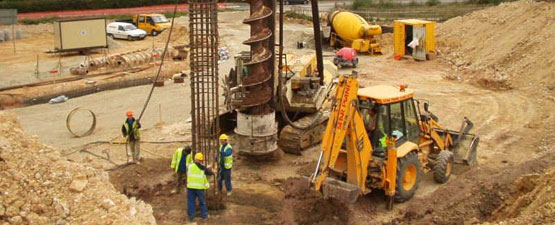Project Geotechnical Engineer Competence for Large-Scale Advancement
Project Geotechnical Engineer Competence for Large-Scale Advancement
Blog Article
How Consulting Engineers Enhance Geotechnical Engineering Projects: Insights Into Their Knowledge, Methodologies, and Collaborative Approaches
Consulting engineers are crucial in improving geotechnical engineering jobs, applying their specialized expertise to navigate the complexities of subsurface problems. Their approaches encompass a variety of website examination techniques, consisting of Requirement Penetration Examinations (SPT) and Cone Infiltration Tests (CPT), which notify critical choices during the design and building and construction stages. Furthermore, their joint methods foster interaction among diverse project stakeholders, eventually shaping the job's trajectory. As we take a look at the multifaceted roles these experts play, it becomes clear that their contributions expand beyond technological knowledge, triggering a closer take a look at the effects for project success.
Duty of Consulting Engineers
The competence of consulting engineers in geotechnical engineering is essential to the effective implementation of building and construction projects. These professionals play a critical function in analyzing soil and rock homes, which are essential factors influencing design and building choices. By performing thorough site investigations, speaking with designers gather necessary information that educates the layout procedure, making certain tasks are improved secure and suitable ground.
Consulting engineers also provide important insights into risk management (geotechnical geologist). They identify possible geotechnical threats, such as landslides, dirt liquefaction, and negotiation problems, enabling stakeholders to execute effective reduction approaches. Their expertise help in enhancing structure layouts, which can bring about substantial price savings and enhanced safety and security
In addition, consulting designers work as an important link in between job owners, engineers, and service providers. Their capability to translate intricate geotechnical information into workable recommendations fosters cooperation and helps with informed decision-making throughout the job lifecycle. This multidisciplinary method not just enhances task effectiveness but likewise ensures conformity with regulatory criteria and ideal techniques.
Trick Approaches in Geotechnical Design

One key methodology is site examination, which entails performing field tests and laboratory analyses to gather information on subsurface problems. Strategies such as Standard Penetration Testing (SPT) and Cone Penetration Testing (CPT) are commonly utilized to examine dirt stratigraphy and toughness. In addition, geophysical approaches, consisting of seismic and electrical resistivity studies, supply non-invasive methods to examine subsurface features.
An additional critical methodology is mathematical modeling, which makes it possible for designers to imitate numerous circumstances and forecast exactly how soil-structure communications will behave under different loading conditions. Limited Component Evaluation (FEA) is a typical approach employed in this context.
Additionally, the layout of structures, maintaining structures, and earthworks relies greatly on these methodologies - geotechnical geologist. By integrating innovative logical tools with field information, consulting engineers can create customized options that deal with specific task difficulties, ultimately contributing to the security and security of construction tasks
Value of Soil Evaluation
Dirt analysis offers as a foundational component in geotechnical engineering, supplying crucial insights into the physical and chemical residential properties of dirt needed for reliable construction planning. Recognizing soil attributes is essential for establishing its load-bearing capacity, water drainage habits, and possibility for settlement or instability. In-depth dirt investigations, including tasting and laboratory screening, aid identify specifications such as dirt type, moisture material, thickness, and shear strength.
These analyses notify the option of appropriate building strategies and materials, inevitably influencing project security and long life. Natural dirts may need different structure layouts compared to granular dirts, requiring tailored engineering remedies. Soil analysis help in recognizing pollutants that can pose threats to human health or the atmosphere, enabling for the growth of mitigation methods.
Including dirt analysis into the very early stages of job advancement assists to reduce unanticipated difficulties, making sure that engineers you could try this out can anticipate and deal with prospective issues prior to they rise. By establishing a detailed understanding of the site conditions, seeking advice from engineers can optimize design efficiency and decrease expenses, consequently improving the overall success of geotechnical design jobs.
Collaborative Approaches in Tasks
Effective geotechnical jobs frequently rest on collaborative strategies that combine diverse know-how from different self-controls. Effective cooperation among speaking with designers, rock hounds, environmental researchers, and building professionals is critical for dealing with intricate difficulties and optimizing task end results. By leveraging the special skills and knowledge of each employee, projects can profit from a holistic understanding of the website conditions, regulative needs, and engineering restraints.
Normal interaction and interdisciplinary meetings assist in the sharing of understandings and foster a society of synergy. These collaborative efforts enable the read this post here recognition of potential risks early in the job lifecycle, permitting for timely mitigation techniques. Moreover, incorporating comments from stakeholders, consisting of local communities and regulative firms, makes certain that all point of views are taken into consideration, boosting project acceptance and compliance.
In addition, the assimilation of advanced technologies, such as Geographic Information Solution (GIS) and Structure Details Modeling (BIM), more boosts cooperation. These devices permit for the real-time sharing of information and visualization of geotechnical conditions, advertising educated decision-making. Inevitably, a joint strategy not just improves task implementation yet additionally lays the structure for ingenious options to complicated geotechnical design obstacles.
Effect On Job Results

Consulting designers utilize advanced techniques such as danger analysis and predictive modeling, which improve the precision of job projections. Their capability to incorporate ingenious modern technologies, like geotechnical instrumentation and data analytics, additionally improves the design and building and construction processes. Because of this, projects experience enhanced performance, reduced expenses, and decreased delays.
In addition, cultivating effective interaction and cooperation amongst team members boosts analytic abilities. When obstacles arise, an unified front enables for speedy recognition of solutions, stopping possible setbacks. Ultimately, the collective efforts of getting in touch with designers add to higher quality outcomes, making sure that tasks fulfill both governing criteria and customer assumptions.
Verdict

Report this page